 |
ARCHITECTURE IN THE UNITED STATES:GENERAL REMARKS, DWELLINGS |
| << RECENT ARCHITECTURE IN EUROPE:MODERN CONDITIONS, FRANCE |
| ORIENTAL ARCHITECTURE:INTRODUCTORY NOTE, CHINESE ARCHITECTURE >> |
CHAPTER
XXVII.
ARCHITECTURE
IN THE UNITED STATES.
BOOKS RECOMMENDED: As before, Fergusson,
Statham. Also, Chandler,
The
Colonial
Architecture
of Maryland, Pennsylvania, and
Virginia.
Cleaveland and
Campbell,
American
Landmarks.
Corner and Soderholz,
Colonial
Architecture in New England.
Crane
and Soderholz, Examples
of Colonial Architecture in Charleston
and Savannah.
Drake,
Historic
Fields and Mansions of
Middlesex.
Everett, Historic
Churches of
America.
King, Handbook
of Boston;
Handbook
of New York.
Little, Early
New England
Interiors.
Schuyler, American
Architecture. Van
Rensselaer, H.
H. Richardson and
His
Works.
Wallis, Old
Colonial Architecture and
Furniture.
GENERAL
REMARKS. The
colonial architecture of modern
times presents a
peculiar
phenomenon.
The colonizing nation, carrying into
its new habitat
the
tastes and
practices
of a long-established civilization,
modifies these only with the
utmost
reluctance,
under the absolute compulsion of new
conditions. When the new home is
virgin
soil, destitute of cultivation,
government, or civilized inhabitants,
the
accompaniments
and activities of civilization introduced
by the colonists manifest
themselves
at first in curious contrast to the
primitive surroundings. The
struggle
between
organized life and chaos, the
laborious subjugation of nature to
the
requirements
of our complex modern life, for a
considerable period absorb
the
energies
of the colonists. The amenities of
culture, the higher intellectual
life, the
refinements
of art can, during this period,
receive little attention. Meanwhile a
new
national
character is being formed; the
people are undergoing the
moral training
upon
which their subsequent achievements must
depend. With the conquest of brute
nature,
however, and the gradual emergence of a
more cultivated class, with
the
growth
of commerce and wealth and the consequent
increase of leisure, the
humanities
find more place in the colonial
life. The fine arts appear
in scattered
centres
determined by peculiarly favorable
conditions. For a long time
they retain the
impress,
and seek to reproduce the forms, of the
art of the mother country. But new
conditions
impose a new development. Maturing
commerce with other lands
brings
in
foreign influences, to which the still
unformed colonial art is
peculiarly
susceptible.
Only with political and commercial
independence, fully developed
internal
resources, and a high national culture do
the arts finally attain, as it
were,
their
majority, and enter upon a truly national
growth.
These
facts are abundantly
illustrated by the architectural history
of the United
States.
The only one among the British
colonies to attain political
independence, it is
the
only one among them whose
architecture has as yet entered upon an
independent
course
of development, and this only within the
last twenty-five or thirty years.
Nor
has
even this development produced as yet a
distinctive local style. It
has, however,
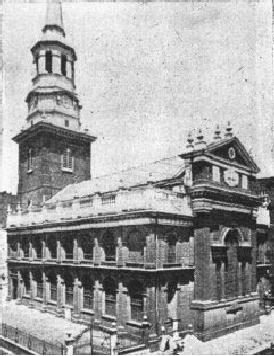
originated
new constructive methods, new types of
buildings, and a distinctively
American
treatment of the composition and the
masses; the decorative details
being
still,
for the most part, derived from
historic precedents. The architecture of
the
other
British colonies has
retained its provincial
character, though producing from
time
to time individual works of
merit. In South America and
Mexico the only
buildings
of importance are Spanish,
French, or German in style,
according to the
nationality
of the architects employed. The following
sketch of American
architecture
refers,
therefore, exclusively to its
development in the United States.
FORMATIVE
PERIOD. Buildings
in stone were not undertaken by the
early English
colonists.
The more important structures in the
Southern and Dutch colonies were
of
brick
imported from Europe. Wood
was, however, the material
most commonly
employed,
especially in New England, and its
use determined in large
measure the
form
and style of the colonial architecture.
There was little or no striving
for
architectural
elegance until well into the eighteenth century, when
Wren's influence
asserted
itself in a modest way in the Middle and
Southern colonies. The very
simple
and
unpretentious town-hall at Williamsburg,
Va., and St. Michael's,
Charleston, are
attributed
to him; but the most that can be said for
these, as for the brick
churches
and
manors of Virginia previous to 1725, is
that they are simple in design
and
pleasing
in proportion, without special
architectural elegance. The same is true
of the
wooden
houses and churches of New England of the
period, except that they are
even
simpler
in design.
FIG.
218.--CHRIST CHURCH,
PHILADELPHIA.
From
1725 to 1775 increased population and
wealth along the coast
brought about
a
great advance in architecture,
especially in churches and in the
dwellings of the
wealthy.
During this period was developed the
Colonial
style,
based on that of the
reigns
of Anne and the first two Georges in
England, and in church architecture
on
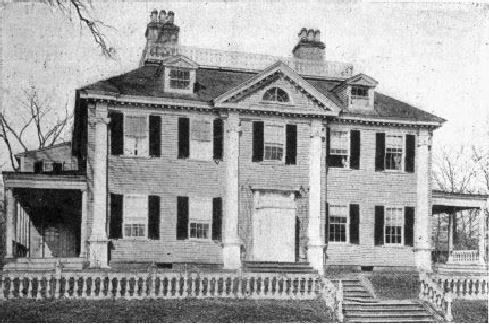
the
models set by Wren and
Gibbs. All the details were,
however, freely modified
by
the
general employment of wood. The
scarcity of architects trained in Old
World
traditions
contributed to this departure from
classic precision of form. The
style,
especially
in interior design, reflected the
cultured taste of the colonial
aristocracy in
its
refined treatment of the woodwork. But
there was little or no architecture of
a
truly
monumental character. Edifices of
stone were singularly few, and
administrative
buildings
were small and modest, owing
to insufficient grants from the Crown,
as
well
as to the poverty of the colonies.
The
churches of this period include a number
of interesting designs,
especially
pleasing
in the forms of their steeples. The
"Old
South" at
Boston (now a museum),
Trinity
at Newport, and St.
Paul's at New
York--one of the few built of stone
(1764)--are
good examples of the style.
Christ
Church at
Philadelphia (172735,
by
Dr. Kearsley) is another example,
historically as well as architecturally
interesting
(Fig.
218); and there are scores of
other churches almost
equally noteworthy,
scattered
through New England, Maryland, Virginia, and the
Middle States.
FIG.
219.--CRAIGIE (LONGFELLOW) HOUSE,
CAMBRIDGE.
DWELLINGS.
These
reflect better than the churches the
varying tastes of the
different
colonies. Maryland and Virginia abound in
fine brick manor-houses,
set
amid
extensive grounds walled in and
entered through iron gates of artistic
design.
The
interior finish of these
houses was often elaborate
in conception and admirably
executed.
Westover (1737), Carter's Grove (1737) in
Virginia, and the Harwood and
Hammond
Houses at Annapolis, Md. (1770), are
examples. The majority of the New
England
houses were of wood, more
compact in plan, more varied
and picturesque in
design
than those of the South, but wanting
somewhat of their stateliness. The
interior
finish of wainscot, cornices,
stairs, and mantelpieces shows,
however, the
same
general style, in a skilful and artistic
adaptation of classic forms to the
slender
proportions
of wood construction. Externally the
orders appear in porches and
in
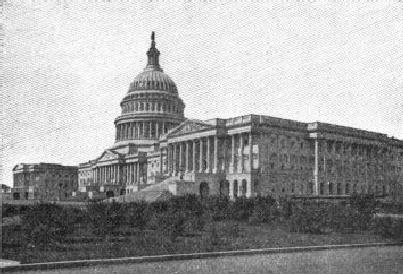
colossal
pilasters, with well designed
entablatures, and windows of Italian
model.
The
influence of the Adams and Sheraton
furniture is doubtless to be seen in
these
quaint
and often charming versions of
classic motives. The Hancock
House, Boston
(of
stone, demolished); the Sherburne
House, Portsmouth (1730); Craigie
House,
Cambridge
(1757, Fig. 219); and Rumford House,
North Woburn (Mass.), are
typical
examples.
In
the Middle States architectural activity
was chiefly centred in
Philadelphia and
New
York, and one or two other towns, where a
number of manor-houses, still
extant,
attest the wealth and taste of the
time. It is noticeable that the veranda
or
piazza
was confined to the Southern
States, but that the climate seems to
have had
little
influence on the forms of roofs.
These were gambrelled,
hipped, gabled, or flat,
alike
in the North and South, according to
individual taste.
PUBLIC
BUILDINGS. Of
public and monumental architecture this
period has little
to
show. Large cities did not exist; New
York, Boston, and Philadelphia were
hardly
more
than overgrown villages. The public
buildings--court-houses and town-halls--
were
modest and inexpensive structures. The
Old State House and Faneuil Hall
at
Boston,
the Town Hall at Newport (R.I.), and Independence Hall
at Philadelphia, the
best
known of those now extant, are not
striking architecturally. Monumental
design
was
beyond the opportunities and means of the
colonies. It was in their churches,
all
of
moderate size, and in their
dwellings that the colonial builders
achieved their
greatest
successes; and these works
are quaint, charming, and
refined, rather than
impressive
or imposing.
FIG.
220.--NATIONAL CAPITOL,
WASHINGTON.
To
the latter part of the colonial period
belong a number of interesting
buildings
which
remain as monuments of Spanish rule in
California, Florida, and the
Southwest.
The old Fort S. Marco, now Fort Marion
(16561756), and the Catholic
cathedral
(1793; after the fire of 1887 rebuilt in
its original form with the
original
fa�ade
uninjured), both at St. Augustine,
Fla.; the picturesque buildings of
the
California
missions (mainly 17691800), the
majority of them now in ruins;
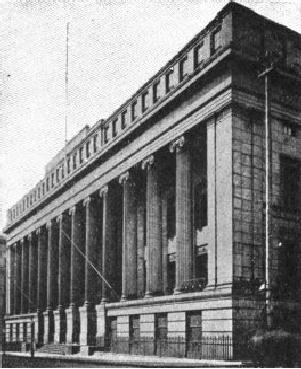
scattered
Spanish churches in California,
Arizona, and New Mexico, and a few
unimportant
secular buildings, display
among their modern and American
settings a
picturesque
and interesting Spanish aspect and
character, though from the point of
view
of architectural detail they represent
merely a crude phase of
the
Churrigueresque
style.
EARLY
REPUBLICAN PERIOD. Between
the Revolution and the War of 1812,
under
the new conditions of independence and
self-government, architecture took
on
a
more monumental character.
Buildings for the State and National
administrations
were
erected with the rapidly increasing
resources of the country. Stone was
more
generally
used; colonnades, domes, and
cupolas or bell-towers, were
adopted as
indispensable
features of civic architecture. In
church-building the Wren-Gibbs
type
continued
to prevail, but with greater correctness
of classic forms. The gambrel
roof
tended
to disappear from the houses of this
period, and there was some
decline in
the
refinement and delicacy of the details of
architecture. The influence of the
Louis
XVI.
style is traceable in many cases, as in
the New York City Hall (180312, by
McComb
and
Mangin),
one of the very best designs of the
time, and in the delicate
stucco-work
and interior finish of many houses, The
original Capitol
at
Washington--
the
central portion of the present
edifice--by Thornton,
Hallet, and
B.
H. Latrobe
(17931830;
Fig. 220), the State
House at
Boston (1795, by Bulfinch), and
the
University
of Virginia, at Charlotteville, by
Thomas
Jefferson (1817;
recently
destroyed
in part by fire), are the most
interesting examples of the classic
tendencies
of
this period. Their freedom from the
rococo vulgarities generally
prevalent at the
time
in Europe is noticeable.
FIG.
221.--CUSTOM HOUSE, NEW
YORK.
THE
CLASSIC REVIVAL. The
influence of the classic revivals of
Europe began to
appear
before the close of this period, and
reached its culmination
about 183040.
It
left its impress most
strongly on our Federal architecture,
although it invaded
domestic
architecture, producing countless
imitations, in brick and wooden
houses,
of
Grecian colonnades and porticos. One of
its first-fruits was the
White House, or
Executive
Mansion, at Washington, by Hoban
(1792),
recalling the large
English
country
houses of the time. The Treasury
and
Patent
Office buildings
at Washington,
the
Philadelphia Mint, the Sub-treasury
and
Custom
House at New York
(the latter
erected
originally for a bank; Fig. 221), and the
Boston
Custom House are
among
the
important Federal buildings of this
period. Several State
capitols were also
erected
under the same influence; and the Marine
Exchange and Girard
College at
Philadelphia
should also be mentioned as
conspicuous examples of the
pseudo-Greek
style.
The last-named building is a Corinthian
dormitory, its tiers of small
windows
contrasting
strangely with its white marble
columns. These classic
buildings were
solidly
and carefully constructed, but lacked the
grace, cheerfulness, and
appropriateness
of earlier buildings. The Capitol at
Washington was during
this
period
greatly enlarged by terminal
wings with fine Corinthian
porticos, of Roman
rather
than Greek design. The Dome, by
Walters,
was not added until 185873; it
is
a
successful and harmonious
composition, nobly completing
the building.
Unfortunately,
it is an afterthought, built of iron painted to
simulate marble, the
substructure
being inadequate to support a
dome of masonry. The Italian or
Roman
style
which it exemplified, in time superseded
the less tractable Greek
style.
THE
WAR PERIOD. The
period from 1850 to 1876 was one of
intense political
activity
and rapid industrial progress. The
former culminated in the terrible
upheaval
of
the civil war; the latter in the
completion of the Pacific Railroad (1869)
and a
remarkable
development of the mining resources and
manufactures of the country. It
was
a period of feverish commercial
activity, but of artistic stagnation, and
witnessed
the
erection of but few buildings of
architectural importance. A number of
State
capitols,
city halls and churches, of considerable
size and cost but of inferior
design,
attest
the decline of public taste and
architectural skill during
these years. The huge
Municipal
Building at Philadelphia and the still
unfinished Capitol at Albany
are full
of
errors of planning and detail which
twenty-five years of elaboration
have failed to
correct.
Next to the dome of the Capitol at
Washington, completed during
this
period,
of which it is the most signal
architectural achievement, its
most notable
monument
was the St.
Patrick's Cathedral at New York,
by Renwick; a
Gothic
church
which, if somewhat cold and mechanical in
detail, is a stately and
well-
considered
design. Its west front and spires
(completed 1886) are
particularly
successful.
Trinity Church (1843, by Upjohn) and
Grace Church (1840, by
Renwick),
though of earlier date, should be
classed with this cathedral as
worthy
examples
of modern Gothic design.
Indeed, the churches designed in this
style by a
few
thoroughly trained architects
during this period are the
most creditable and
worthy
among its lesser
productions. In general an
undiscriminating eclecticism of
style
prevailed, unregulated by sober
taste or technical training. The
Federal
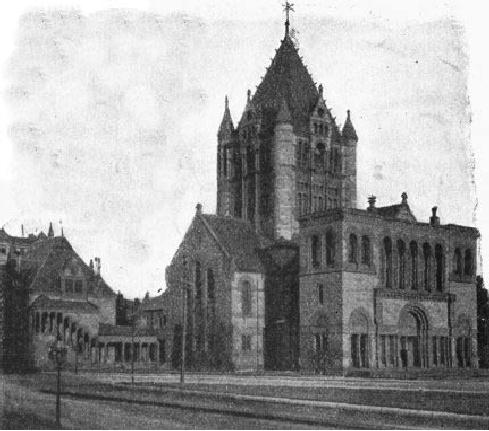
buildings
by Mullett
were
monuments of perverted design in a
heavy and inartistic
rendering
of French Renaissance motives. The New
York Post Office and the
State,
Army
and Navy Department building at
Washington are examples of this
style.
FIG.
222.--TRINITY CHURCH,
BOSTON.
THE
ARTISTIC AWAKENING. Between
1870 and 1880 a remarkable series
of
events
exercised a powerful influence on the
artistic life of the United States.
Two
terrible
conflagrations in Chicago (1871) and
Boston (1872) gave
unexampled
opportunities
for architectural improvement and greatly
stimulated the public
interest
in
the art. The feverish and abnormal
industrial activity which followed the
war and
the
rapid growth of the parvenu spirit
were checked by the disastrous "panic"
of
1873.
With the completion of the Pacific
railways and the settlement of new
communities
in the West, industrial prosperity, when
it returned, was established
on
a
firmer basis. An extraordinary
expansion of travel to Europe
began to disseminate
the
seeds of artistic culture
throughout the country. The successful
establishment of
schools
of architecture in Boston (1866) and
other cities, and the opening
or
enlargement
of art museums in New York, Boston,
Philadelphia, Baltimore,
Detroit,
Milwaukee,
and elsewhere, stimulated the artistic
awakening which now manifested
itself.
In architecture the personal influence of
two men, trained in the Paris
�cole
des
Beaux-Arts, was especially felt--of
R.
M. Hunt (182795)
through his words and
deeds
quite as much as through his works; and
of H.
H. Richardson (182886)
predominantly
through his works. These two men, with
others of less fame but
of
high
ideals and thorough culture, did much to
elevate architecture as an art in
the
public
esteem. To all these influences new
force was added by the
Centennial
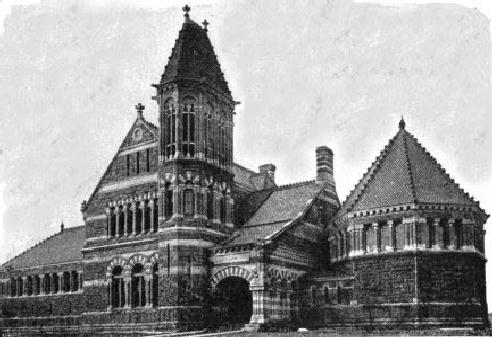
Exhibition
at Philadelphia (1876). Here for the
first time the American
people were
brought
into contact, in their own land, with the products of
European and Oriental
art.
It was to them an artistic revelation,
whose results were prompt and
far-
reaching.
Beginning first in the domain of
industrial and decorative art,
its
stimulating
influence rapidly extended to
painting and architecture, and
with
permanent
consequences. American students
began to throng the centres of Old
World
art, while the setting of higher
standards of artistic excellence at
home, and
the
development of important art-industries,
were other fruits of this
artistic
awakening.
The recent Columbian Exhibition at
Chicago (1893), its latest and
most
important
manifestation, has added a new
impulse to the movement, especially
in
architecture.
FIG.
223.--LIBRARY AT WOBURN,
MASS.
STYLE
IN RECENT ARCHITECTURE. The
rapid increase in the number of
American
architects trained in Paris or under the
indirect influence of the �cole
des
Beaux-Arts
has been an important factor
in recent architectural progress. Yet it
has
by
no means imposed the French
academic formul� upon American
architecture. The
conditions,
materials, and constructive processes
here prevailing, and above all
the
eclecticism
of the public taste, have
prevented this. The French
influence is perceived
rather
in a growing appreciation of monumental
design in the planning,
composition,
and
setting of buildings, than in any direct
imitation of French models. The
Gothic
revival
which prevailed more or less widely from
1840 to 1875, as already noticed,
and
of which the State
Capitol at Hartford
(Conn.; 187578), and the Fine
Arts
Museum
at
Boston, were among the last
important products, was
generally confined
to
church architecture, for which Gothic
forms are still largely
employed, as in the
Protestant
Cathedral
of
All
Saints now
building at Albany (N.Y.), by an
English
architect.
For the most part the works of the
last twenty years show a more or
less
judicious
eclecticism, the choice of style
being determined partly by the person
and
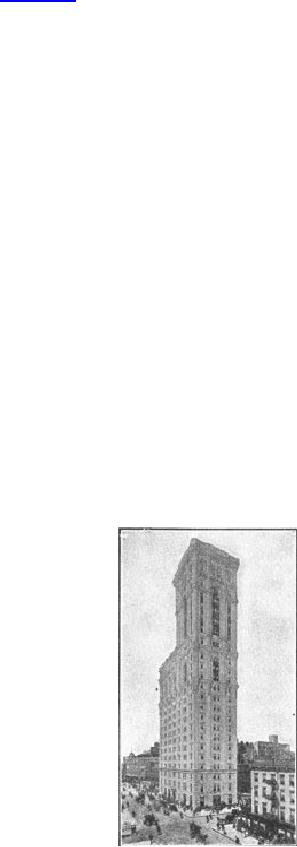
training
of the designer, partly by the nature of the
building. The powerfully
conceived
works of Richardson, in a free
version of the French Romanesque, for
a
time
exercised a wide influence,
especially among the younger
architects. Trinity
business
buildings, and finally the impressive
County
Buildings at
Pittsburgh (Pa.),
all
treated in this style, are
admirable rather for the strong
individuality of their
designer,
displayed in their vigorous composition,
than on account of the historic
style
he employed (Fig. 223). Yet it appeared
in his hands so flexible and
effective
that
it was widely imitated. But if easy to
use, it is most difficult to
use well; its
forms
are too massive for ordinary
purposes, and in the hands of inferior
designers it
was
so often travestied that it has now
lost its wide popularity.
While a number of
able
architects have continued to
use it effectively in ecclesiastical,
civic, and even
commercial
architecture, it is being generally
superseded by various forms of
the
Renaissance.
Here also a wide eclecticism
prevails, the works of the same
architect
often
varying from the gayest Francis I.
designs in domestic architecture, or
free
adaptations
of Quattrocento details for theatres and
street architecture, to the
most
formal
classicism in colossal
exhibition-buildings, museums, libraries,
and the like.
Meanwhile
there are many more or less
successful ventures in other
historic styles
applied
to public and private edifices.
Underlying this apparent confusion,
almost
anarchy
in the use of historic styles, the
careful observer may detect
certain
tendencies
crystallizing into definite form. New
materials and methods of
construction,
increased attention to detail, a
growing sense of
monumental
requirements,
even the development of the elevator as a
substitute for the grand
staircase,
are leaving their mark on the planning,
the proportions, and the artistic
composition
of American buildings, irrespective of
the styles used. The art is with
us
in
a state of transition, and open to
criticism in many respects; but it
appears to be
full
of life and promise for the
future.
FIG.
224.--"TIMES" BUILDING, NEW
YORK.
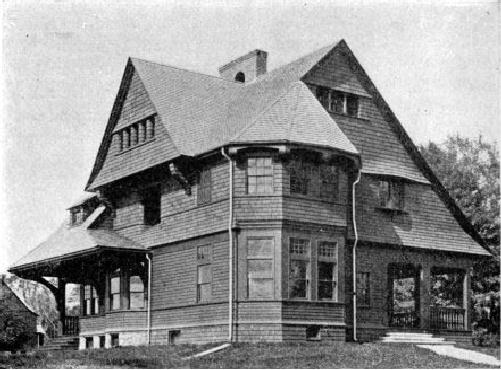
COMMERCIAL
BUILDINGS. This
class of edifices has in our
great cities
developed
wholly
new types, which have taken
shape under four imperative influences.
These
are
the demand for fire-proof construction,
the demand for well-lighted offices,
the
introduction
of elevators, and the concentration of
business into limited areas,
within
which
land has become inordinately
costly. These causes have
led to the erection of
buildings
of excessive height (Fig. 224); the
more recent among them
constructed
with
a framework of iron or steel columns and
beams, the visible walls
being a mere
filling-in.
To render a building of twenty stories
attractive to the eye, especially
when
built
on an irregular site, is a difficult
problem, of which a wholly
satisfactory
solution
has yet to be found. There have
been, however, some notable
achievements
in
this line, in most of which the principle
has been clearly recognized
that a lofty
building
should have a well-marked
basement or pedestal and a somewhat
ornate
crowning
portion or capital, the intervening
stories serving as a die or
shaft and
being
treated with comparative simplicity. The
difficulties of scale and of
handling
one
hundred and fifty to three hundred windows of uniform
style have been
surmounted
with conspicuous skill (American
Surety Building and
Broadway
Chambers,
New York; Ames Building, Boston;
Carnegie Building, Pittsburgh;
Union
Trust,
St. Louis).
FIG.
225.--COUNTRY HOUSE,
MASSACHUSETTS.
In
some cases, especially in
Chicago and the Middle West, the metallic
framework is
suggested
by slender piers between the
windows, rising uninterrupted from
the
basement
to the top story. In others, especially in New York
and the East, the walls
are
treated as in ordinary masonry
buildings. The Chicago school is
marked by a
more
utilitarian and unconventional treatment,
with results which are
often
extremely
bold and effective, but rarely as
pleasing to the eye as those
attained by
the
more conservative Eastern
school. In the details of American
office-buildings
every
variety of style is to be met with; but the
Romanesque and the Renaissance,
freely
modified, predominate. The tendency
towards two or three well-marked
types
in
the external composition of these
buildings, as above suggested,
promises,
however,
the evolution of a style in which the
historic origin of the details will be
a
secondary
matter. Certain Chicago
architects have developed an
original treatment of
architectural
forms by exaggerating some of the
structural lines, by suppressing
the
mouldings
and more familiar historic
forms, and by the free use of flat
surface
ornament.
The Schiller, Auditorium, and Fisher
Buildings, all at Chicago,
Guaranty
Building,
Buffalo, and Majestic Building,
Detroit, are examples of this
personal style,
which
illustrates the untrammelled freedom of
the art in a land without traditions.27
DOMESTIC
ARCHITECTURE. It is in this
field that the most characteristic
and
original
phases of American architecture
are to be met with, particularly in rural
and
suburban
residences. In these the peculiar
requirements of our varying climates
and
of
American domestic life have
been studied and in large
measure met with great
frankness
and artistic appreciation. The broad
staircase-hall, serving often as a
sort
of
family sitting-room, the piazza, and a
picturesque massing of steep
roofs, have
been
the controlling factors in the evolution
of two or three general types
which
appear
in infinite variations. The material
most used is wood, but this
has had less
influence
in the determination of form than might have
been expected. The
artlessness
of the planning, which is arranged to
afford the maximum of convenience
rather
than to conform to any traditional type,
has been the element of
greatest
artistic
success. It has resulted in
exteriors which are the natural outgrowth
of the
interior
arrangements, frankly expressed, without
affectation of style (Fig. 225).
The
resulting
picturesqueness has, however, in many
cases been treated as an end
instead
of
an incidental result, and the affectation
of picturesqueness has in such
designs
become
as detrimental as any affectation of
style. In the internal treatment
of
American
houses there has also
been a notable artistic
advance, harmony of color
and
domestic comfort and luxury being
sought after rather than
monumental effects.
A
number of large city and country houses
designed on a palatial scale
have,
however,
given opportunity for a more
elaborate architecture; notably the
Vanderbilt,
Villard,
and Huntington residences at New York, the great
country-seat of Biltmore,
near
Asheville (N.C.), in the Francis I.
style (by R. M. Hunt), and many
others.
OTHER
BUILDINGS. American
architects have generally
been less successful
in
public,
administrative, and ecclesiastical
architecture than in commercial
and
domestic
work. The preference for small parish
churches, treated as
audience-rooms
rather
than as places of worship, has
interfered with the development of noble
types
of
church-buildings. Yet there are
signs of improvement; and the new
Cathedral
of
St.
John the Divine at New York,
in a modified Romanesque style,
promises to be a
worthy
and monumental building. In semi-public
architecture, such as
hotels,
theatres,
clubs, and libraries, there
are many notable examples of
successful design.
The
Ponce
de Leon Hotel at
St. Augustine, a sumptuous and
imposing pile in a
free
version
of the Spanish Plateresco; the Auditorium
Theatre at Chicago, the
Madison
Square
Garden and the Casino at New York, may be
cited as excellent in
general

conception
and well carried out in detail,
externally and internally. The Century
and
Metropolitan
Clubs at New York, the Boston
Public Library, the
Carnegie Library at
Pittsburgh,
the Congressional
Library at
Washington, and the recently
completed
Minnesota
State
Capitol at
St. Paul, exemplify in
varying degrees of excellence
the
increasing
capacity of American architects for
monumental design. This was
further
shown
in the buildings of the Columbian
Exposition at
Chicago in 1893. These, in
spite
of many faults of detail, constituted an
aggregate of architectural splendor
such
as
had never before been seen
or been possible on this
side the Atlantic. They further
brought
architecture into closer union with the
allied arts and formed an
object
lesson
in the value of appropriate landscape
gardening as a setting to
monumental
structures.
It
should be said, in conclusion, that with
the advances of recent years in
artistic
design
in the United States there has
been at least as great
improvement in scientific
construction.
The sham and flimsiness of the Civil War
period are passing away,
and
solid
and durable building is becoming
more general throughout the country,
but
especially
in the Northeast and in some of the great
Western cities, notably
in
Chicago.
In this onward movement the Federal
buildings--post-offices, custom-
houses,
and other governmental edifices--have
not, till lately, taken high rank.
Although
solidly and carefully constructed,
those built during the period
18751895
were
generally inferior to the best work
produced by private enterprise, or by
State
and
municipal governments. This
was in large part due to
enactments devolving upon
the
supervising architect at Washington the
planning of all Federal buildings, as
well
as
a burden of supervisory and clerical
duties incompatible with the highest
artistic
results.
Since 1898, however, a more
enlightened policy has
prevailed, and a number
of
notable designs for Federal
buildings have been secured
by carefully-conducted
competitions.
27.
See
Appendix,
D and
E.
Table of Contents:
- PRIMITIVE AND PREHISTORIC ARCHITECTURE:EARLY BEGINNINGS
- EGYPTIAN ARCHITECTURE:LAND AND PEOPLE, THE MIDDLE EMPIRE
- EGYPTIAN ARCHITECTURE—Continued:TEMPLES, CAPITALS
- CHALDÆAN AND ASSYRIAN ARCHITECTURE:ORNAMENT, MONUMENTS
- PERSIAN, LYCIAN AND JEWISH ARCHITECTURE:Jehovah
- GREEK ARCHITECTURE:GENERAL CONSIDERATIONS, THE DORIC
- GREEK ARCHITECTURE—Continued:ARCHAIC PERIOD, THE TRANSITION
- ROMAN ARCHITECTURE:LAND AND PEOPLE, GREEK INFLUENCE
- ROMAN ARCHITECTURE—Continued:IMPERIAL ARCHITECTURE
- EARLY CHRISTIAN ARCHITECTURE:INTRODUCTORY, RAVENNA
- BYZANTINE ARCHITECTURE:DOMES, DECORATION, CARVED DETAILS
- SASSANIAN AND MOHAMMEDAN ARCHITECTURE:ARABIC ARCHITECTURE
- EARLY MEDIÆVAL ARCHITECTURE:LOMBARD STYLE, FLORENCE
- EARLY MEDIÆVAL ARCHITECTURE.—Continued:EARLY CHURCHES, GREAT BRITAIN
- GOTHIC ARCHITECTURE:STRUCTURAL PRINCIPLES, RIBBED VAULTING
- GOTHIC ARCHITECTURE IN FRANCE:STRUCTURAL DEVELOPMENT
- GOTHIC ARCHITECTURE IN GREAT BRITAIN:GENERAL CHARACTER
- GOTHIC ARCHITECTURE IN GERMANY, THE NETHERLANDS, AND SPAIN
- GOTHIC ARCHITECTURE IN ITALY:CLIMATE AND TRADITION, EARLY BUILDINGS.
- EARLY RENAISSANCE ARCHITECTURE IN ITALY:THE CLASSIC REVIVAL, PERIODS
- RENAISSANCE ARCHITECTURE IN ITALY—Continued:BRAMANTE’S WORKS
- RENAISSANCE ARCHITECTURE IN FRANCE:THE TRANSITION, CHURCHES
- RENAISSANCE ARCHITECTURE IN GREAT BRITAIN AND THE NETHERLANDS
- RENAISSANCE ARCHITECTURE IN GERMANY, SPAIN, AND PORTUGAL
- THE CLASSIC REVIVALS IN EUROPE:THE EIGHTEENTH CENTURY
- RECENT ARCHITECTURE IN EUROPE:MODERN CONDITIONS, FRANCE
- ARCHITECTURE IN THE UNITED STATES:GENERAL REMARKS, DWELLINGS
- ORIENTAL ARCHITECTURE:INTRODUCTORY NOTE, CHINESE ARCHITECTURE
- APPENDIX.